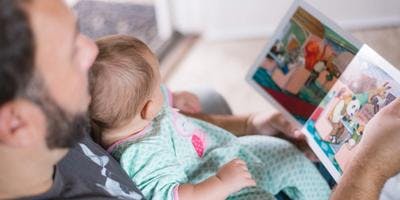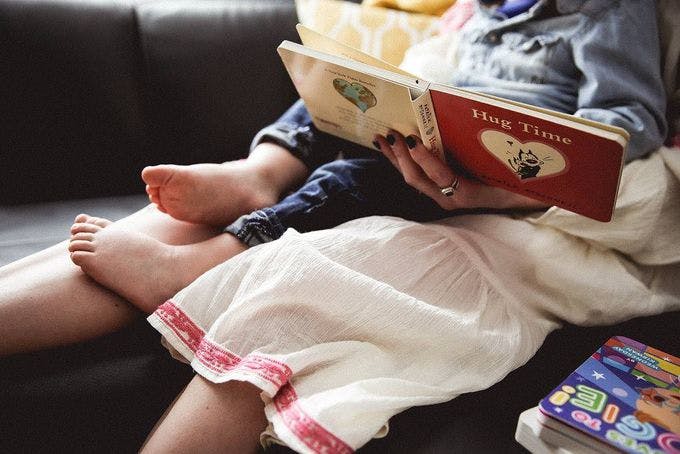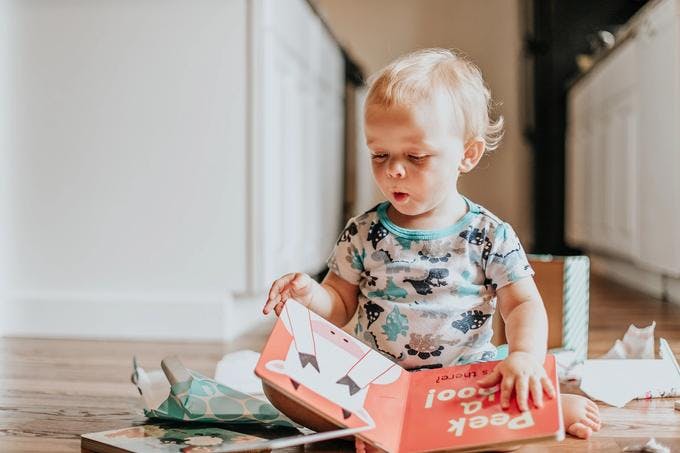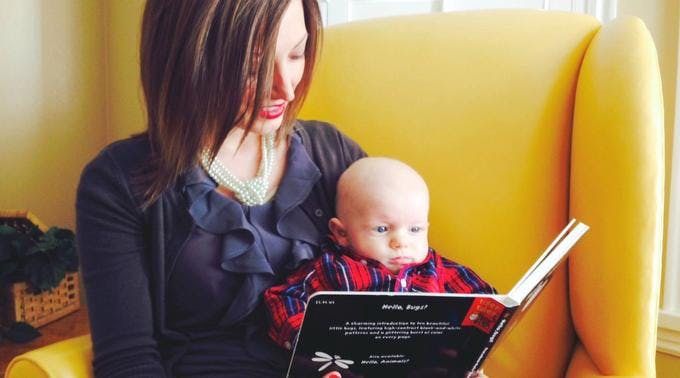

First things first, congratulations on becoming a parent! What an exciting, rewarding—and challenging!—moment.
We know you’ve got a lot of things on your mind right now, so we want to alleviate one area of pressure for you—and we think you’ll find it helps in many areas!—and that’s reading with your child. It won’t take long to discover that reading with your baby isn’t just another “to do” item; instead, it’s a fun, enriching part of your and your new child’s world.
Welcome (Back) to the World of Children’s Literature
Unless you’re one of the (brilliant) individuals who makes their living working in children’s books, chances are you might be a little out of touch with the space. So as a first step, it’s time to re-familiarize yourself with the magical world of children’s literature.
See, children’s books aren’t just fun for kids; they’re also a joy for adults. As C.S. Lewis said, “A children’s story that can only be enjoyed by children is not a good children’s story in the slightest.”
We’re confident that you’re going to find yourself enjoying children’s literature as much, if not more, than your child.
But before we jump into the books themselves, let’s take a moment to look at why it’s important to read with your new baby.
Why to Read
Reading with children is beneficial in many ways. As you would expect, it helps them become better readers themselves. But the benefits of reading extend beyond language and literacy strengths into other intellectual areas, too, as well as to family, social, and emotional benefits.

As the American Academy of Pediatricians has said, “reading regularly with young children stimulates optimal patterns of brain development, strengthens parent-child relationships . . . [and] builds language, literacy, and social-emotional skills that last a lifetime.”
Did you catch all of that? Not only does reading have an intellectual benefit—the stimulation of optimal patterns of brain development—but it also has a strengthening effect on parent-child relationships and helps with social and emotional development. Ding, ding, ding, we have a winner!
Intellectual Benefits
“If every child were read to daily from infancy, it would revolutionize education in this country!” This statement by former Secretary of Education Richard W. Riley succinctly and powerfully captures the link between early reading and future educational success.
A child’s brain grows to 90% of its adult weight during her first three years of life, and during these years she develops most of her capacity for learning. By reading to children, parents are able to activate many of these brain cells during the crucial years for brain development.
While it makes perfect sense that reading to your child from an early age would correlate to their being better readers—something we all want for our children—there’s plenty of research showing that reading to babies and toddlers positively impacts all facets of their formal education.
As author and professor Daniel Willingham explains, “Reading follows an upward spiral . . . kids who read well don’t just do better in English class—it helps them in math, science and every other class, too.” And scientific journalist and author Dan Hurley writes that, based on years of research, “reading and intelligence have a relationship so close as to be symbiotic.”
One young woman applying to colleges was attending a Harvard admissions meeting before a campus tour. At the end of the meeting, the floor was opened for questions, and a parent raised his hand and asked, “As a parent, what can I do to help my child get into Harvard?” The admissions officer responded unhesitatingly and emphatically, “Read to them.”
Family Relationships and Bonding
In addition to being intellectually beneficial, reading with your child also offers moments to bond, create, and strengthen your relationship. We love the sweet sentiment captured in a poem by author Strickland Gillilan:
“You may have tangible wealth untold.
Caskets of jewels and coffers of gold.
Richer than I you can never be—
I had a mother who read to me."

As Dr. Mary Ann Abrams explains, “Reading a book to your newborn is a one-on-one activity that you can really turn into a special time with your baby. It exposes the baby to the sound of your voice, which is soothing for him.”
As author, mother, and children’s book columnist Meghan Cox Gurdon writes, reading with kids is an “elixir so strong that a daily dose . . . [will] make your family smarter, happier, healthier, more successful, and more closely attached.” She continues, “Reading out loud is probably the least expensive and most effective intervention we can make for the good of our families . . . ”
It won’t take long for you to experience the reward of reading together for yourself. It feels good. It feels rewarding. In a survey of 2,000 parents by custom book publisher Wonderbly, parents said that reading with their kids was the best part of the day.
And children feel the same. A study performed by YouGov aimed at looking for predictors that children would read frequently found that “children in the survey frequently cited reading aloud as a special bonding time with their parents.”
If you take a minute to think about it, it seems intuitive. Taking time to sit close, focus on the same story together, and enjoy one anothers’ company creates precious bonding moments that both parents and children can draw on later.
Social and Emotional Benefits
In addition to being intellectually beneficial and strengthening family relationships, reading to your baby is also important for his social and emotional development.
“Many pediatricians now believe that a child who has never held a book or listened to a story is not a fully healthy child,” says Dr. Perri Klass, National Medical Director of Reach Out and Read.

And as Pamela Paul, editor of The New York Times Book Review, writes, “We are all agreed that reading makes you more knowledgeable and a better learner. What’s becoming more and more clear is that it also makes you a better-adjusted, better human being.”
A better human being—can that be true? Indeed it is, as a study from Scientific American confirms: reading fiction can help kids learn the “importance of understanding those who are different from ourselves.” In other words, it can help kids be more empathetic.
By reading and being exposed to a variety of stories, children gain essential communication skills and see appropriate reactions to experiences exhibited in the interactions book characters have. They will be able to better identify how to express themselves and relate to others appropriately.
When to Read
Now that you better understand why it’s important to read with your baby, let’s look at when to read with your child.
There are really two parts to the question of when to read to a child: first, at what age should I start reading to a child, and second, how do I make time in the day to read together.

When it comes to when to begin reading with a child, you can’t start too early. Even reading to a baby in the womb is beneficial. By the third trimester of a pregnancy, a baby’s hearing has already developed to the point where the fetus can hear outside sounds. The steady pace of reading can lower the baby’s heart rate and promote language learning. It’s also helpful in providing a moment of relaxation for the expecting, mom- and dad-to-be and in establishing a pattern you’ll want to follow for years to come.
Just as some parents begin to play Mozart to a baby while still in the womb, others eagerly begin to share their favorite literature. One of our own Bookroo Crew members recently finished reading The Hobbit to their baby in utero.
As for when in the day to read, there’s no right or wrong time. The important thing is to be consistent. This is often helped by finding something else that you do on a regular basis and associating reading with it. That certainly makes bedtime a winner, as it (hopefully) happens every day—we’re crossing our fingers your new one is getting some sleep, and you are too! Meals are another option, though we recommend reading before mealtime, because we know from experience that everyone can feel a little worn out by the time baby has eaten and everything is cleaned up. Reading first thing in the morning or after the “workday” (let’s be real, does the workday as a parent really ever end?) to wind down can also be good moments. And of course you don’t have to choose just one! Try out a few and see which work well for you.
We know of some new parents who really struggled with helping their child be calm and prepared for bed. He just wanted to keep going and doing, and he hated and fought bedtime and sleep. They found incorporating reading into the bedtime routine really saved their sanity as it was something the child wanted to do and helped him begin to calm down and prepare for sleep.
And if reading time doesn’t happen some days while baby is awake, don’t despair! Just as reading to a baby in utero is beneficial to a baby, reading to a sleeping child also has positive impacts. While sleeping through school might not have worked too well for you, it turns out your baby can pull it off. The sounds an infant hears while sleeping continue to help brain development and language learning.
How Much to Read
Many organizations encourage parents to read between 20 and 30 minutes each day with a child, while other organizations challenge parents to read 1,000 or even 5,000 books with their child by kindergarten. While we support aiming for such laudable targets and believe achieving them is beneficial for children, when it comes to the question of how much to read to your child, the most important advice we have is to not let yourself be overwhelmed by the task.

Remember, perfect is often the enemy of good. So don’t let your inability to read a certain number of books or pages or for a certain amount of time get in the way of, or detract from the enjoyment of, reading one book or one page.
Our recommendation is to read daily with your child, and we’re confident that if you’re reading good books, they’ll take care of the rest—you’ll want to read as often and as long as you can! #somanybookssolittletime
What to Read
Now that we’ve looked at why reading is important, when to read with a baby, and how to ready to a baby, here comes the fun part: choosing what to read.
The truth is, for young infants, what you’re reading is not really critical—the important thing is that you are reading. Reading the newspaper, reading a magazine, reading a collection of essays—it’s the reading that matters most.
However, we highly recommend reading children’s books. Except for the brilliant individuals among us who make children’s literature their life’s work, most of us leave the magical world of kids’ books behind when we stop reading them ourselves. As you reacquaint yourself, you’ll experience powerful waves of excitement and some nostalgia as you rediscover books you loved as a child and look forward to now sharing them with your own child. In addition to sharing old favorites, you’ll also want to share new discoveries together. Kids’ books are amazing: remarkably insightful, and emotionally moving—you’ll laugh, you’ll cry, you’ll hug your child close.
We think that you’ll find you enjoy the stories just as much, or more, than your baby. And when you’re reading good, interesting stories, you’ll be looking forward to reading time as much or more than your baby, and that will help you with consistency.
As avid reader and essayist Jia Tolentino writes, “A really good middle-grade novel will supersede a lot of contemporary fiction in terms of economy, lucidity and grace.” Pamela Paul shares a similar sentiment. She writes, “Everyone should enjoy picture books. . . . They are visual storytelling masterpieces.”

We also strongly encourage reading from physical books instead of from a tablet or other device. Studies show that reading from a physical book offers a better reading experience for both kids and parents. Reading from a device has too many distractions, even for—or maybe especially for—a parent. You’ll find reading from a physical book to be a more immersive, engaging experience. Many kids books, especially picture books, are designed as physical products, from the layout of the illustrations to the texture of the paper, and these enriching details are diminished or lost entirely by reading from a device. As your baby begins to be more aware of his surroundings, seeing you hold a physical book will also be the best reading example.
As you’re reading to your child, it won’t take long before he wants to help you hold the book and turn the pages. For this reason, we highly recommend board books for babies and toddlers who start to show interest in holding books themselves—the thick pages are perfect for developing motor skills and are durable enough to double as a chew toy. (If you’re not familiar with the difference between board books and picture books, check out our guide explaining the key characteristics of each type.) We will often hand a board book to our own toddler to hold while we read to her from another book.
Also, audio books and minimally animated or automated readings are not a replacement for your time reading with your child. While some reading is better than none, your child will benefit most from hearing you read and the time you spend together as you take time to read to her. The spontaneous dialogue between you and your child is an enriching part of the reading experience as you ask reflective questions, laugh, and enjoy together. These opportunities are lost when you turn storytime over to someone, or something, else.
And now we come to the part we love best: sharing specific book recommendations!
Classic Board Books for Babies
- Margaret Wise Brown, Clement Hurd
- Eric Carle
- John Archambault, Lois Ehlert
- Rod Campbell
Best Bedtime Books for Babies
- Elizabeth McPike, Patrice Barton
- Il Sung Na
- Sandra Boynton
Popular Board Books for Babies
- Alice Schertle, Jill McElmurry
- Joan Holub, Daniel Roode
Favorite Board Books for Babies
- Deborah Diesen, Dan Hanna
- Giles Andreae, Guy Parker-Rees
Best Picture Books to Read to Babies
- Max Lucado, Sergio Martinez
- Stephan Lomp
Best Chapter Books to Read Aloud to Babies
- Roald Dahl, Quentin Blake
- Antoine de Saint-Exupery, Richard Howard

































